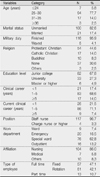Abstract
Purpose
This study was conducted to investigate gender stereotype and job satisfaction, and to identify the relationship between gender stereotype and job satisfaction in male nurses.
Methods
The participants were 165 male nurses who worked in the Seoul, Gyeonggi and Daejeon areas. Data were collected from August 31th, 2009 to October 15th, 2009. A survey questionnaire was used to measure demographics, gender-role identity, gender stereotype and job satisfaction. Data were analyzed using SPSS/Win 12.0 version.
Results
The mean score for gender stereotype was 2.81 points out of a possible 5. There were statistically significant differences in gender stereotype by general characteristics such as career in the current department (F=5.249, p=.007) and position (t=2.547, p=.012). The scores for gender stereotype were significantly higher in the group with less than five years in the current department and in the staff nurse group. The mean score for job satisfaction was 2.95 out of a possible 5. There was a significant negative correlation between gender stereotype and job satisfaction.
Figures and Tables
References
1. Ahn SH. Analysis of studies on job satisfaction among Korean nurses. J Korean Acad Nurs Adm. 2000. 6(3):319–331.
2. An KN. Investigation on the work pressure and job satisfaction recognized by preceptors. 2006. Kangwon: Kangwon National University;Unpublished master's thesis.
3. Choi SJ. Male students' lived experience in the femaledominant nursing college. 2002. Daegu: Keimyung University;Unpublished master's thesis.
4. Cyr JP. Male in nursing. Nurs Manage. 1992. 23(7):54–55.
5. Hur HK. A study for factors influencing turnover intention of hospital nurses. 1982. Seoul: Yonsei University;Unpublished master's thesis.
6. Kim EY. A study on gender stereotypes: The influence of age and education factors on gender stereotypes. 1991. Seoul: Ewha Womans University;Unpublished master's thesis.
7. Korean Nurses Association. Year book of Nursing Statistics. 2007. The Korean Research Institute for Nursing Policy, Korean Nurses Association.
8. Lee DJ. The relationships among satisfaction in major, gender identity, and gender stereotypes of male nursing students. 2004. Seoul: Yonsei University;Unpublished master's thesis.
9. Lee ERS. A study on the sex role identity and sex role stereotypes of some high school teachers and students. 2001. Kangwon: Kangwon National University;Unpublished master's thesis.
10. Lee SY. A study on job satisfaction and intentions of turnover of male nurses. 2004. Seoul: Hanyang University;Unpublished master's thesis.
11. Noh YH. A study on the nurses' job satisfaction in the teaching hospital. 2001. Cheonan: Dankook University;Unpublished master's thesis.
12. Park YJ. A study on college student's gender-role identity & its relationship to sex stereotype and self-consciousness. 2000. Seoul: Sogang University;Unpublished master's thesis.
13. Sohn HJ. A study on the relation among gender-role identity, gender-role stereotypes and psychological separation from parents. 2007. Seoul: Sogang University;Unpublished master's thesis.
14. Son HM, Ko BH, Kim CM, Moon JH, Lee MS. The male nurses' experiences of adaptation in clinical setting. J Korean Acad Nurs. 2003. 33(1):17–25.

15. Song MS. A study of the correlation between role stress, burnout and work satisfaction levels among operating room nurses. 1984. Seoul: Yonsei University;Unpublished master's thesis.




 PDF
PDF ePub
ePub Citation
Citation Print
Print







 XML Download
XML Download